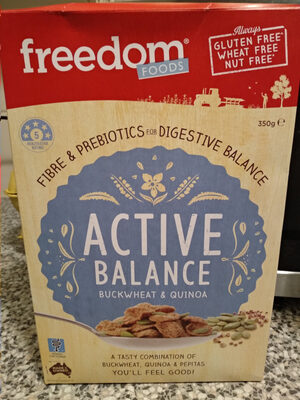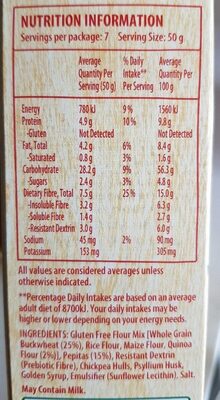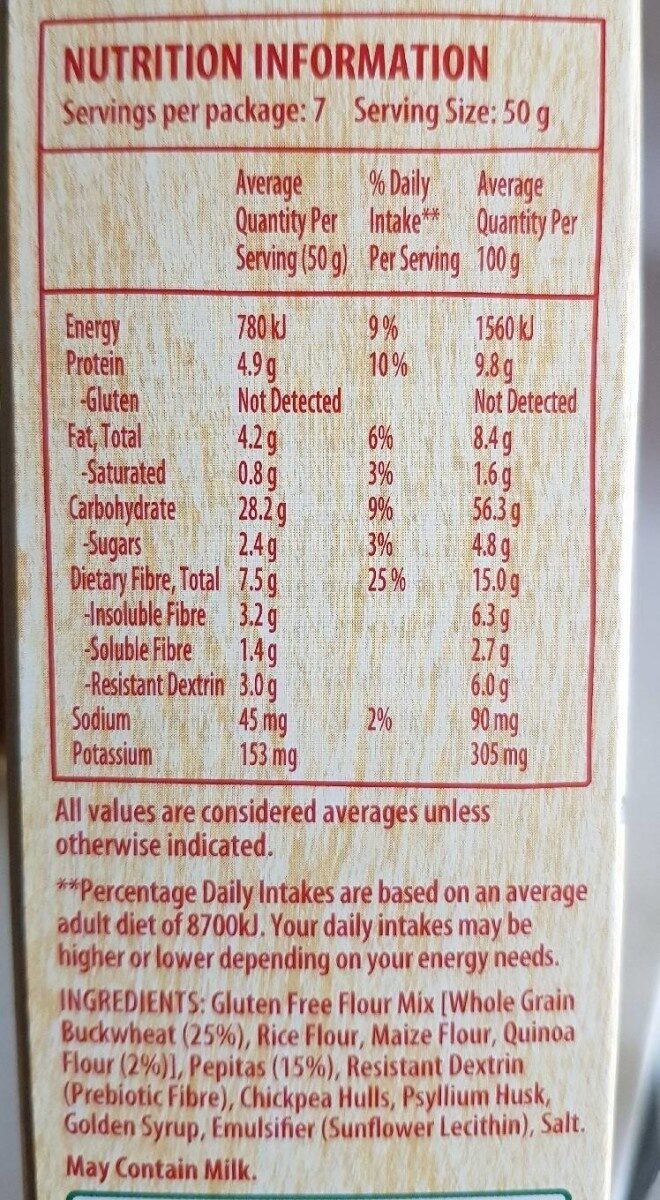Help us make food transparency the norm!
As a non-profit organization, we depend on your donations to continue informing consumers around the world about what they eat.
The food revolution starts with you!
Active balance buckwheat & quinoa - freedom foods - 350g
Active balance buckwheat & quinoa - freedom foods - 350g
This product page is not complete. You can help to complete it by editing it and adding more data from the photos we have, or by taking more photos using the app for Android or iPhone/iPad. Thank you!
×
Barcode: 9315090201345 (EAN / EAN-13)
Quantity: 350g
Packaging: Cardboard
Brands: freedom foods
Categories: Plant-based foods and beverages, Plant-based foods, Breakfasts, Cereals and potatoes, Cereals and their products, Breakfast cereals, Flakes, Cereal flakes, Extruded cereals, Extruded flakes, Mixed cereal flakes
Labels, certifications, awards:
No gluten, Health Star Rating, Health Star Rating 5
Origin of ingredients: 70% Australia
Manufacturing or processing places: Australia
Link to the product page on the official site of the producer: http://www.freedomfoods.com.au
Stores: Woolworths, Coles
Countries where sold: Australia
Matching with your preferences
Health
Ingredients
-
15 ingredients
Gluten Free Flour Mix [Whole Grain Buckwheat (25%), Rice Flour, Maize Flour, Quinoa Flour (2%)1, Pepitas (15%), Resistant Dextrin (Prebiotic Fibre), Chickpea Hulls, Psyllium Husk, Golden Syrup, Emulsifier (Sunflower Lecithin), Salt.
Food processing
-
Ultra processed foods
Elements that indicate the product is in the 4 - Ultra processed food and drink products group:
- Additive: E1400 - Dextrin
- Additive: E322 - Lecithins
- Ingredient: Emulsifier
- Ingredient: Invert sugar
Food products are classified into 4 groups according to their degree of processing:
- Unprocessed or minimally processed foods
- Processed culinary ingredients
- Processed foods
- Ultra processed foods
The determination of the group is based on the category of the product and on the ingredients it contains.
Additives
-
E1400 - Dextrin
Dextrin: Dextrins are a group of low-molecular-weight carbohydrates produced by the hydrolysis of starch or glycogen. Dextrins are mixtures of polymers of D-glucose units linked by α--1→4- or α--1→6- glycosidic bonds. Dextrins can be produced from starch using enzymes like amylases, as during digestion in the human body and during malting and mashing, or by applying dry heat under acidic conditions -pyrolysis or roasting-. The latter process is used industrially, and also occurs on the surface of bread during the baking process, contributing to flavor, color and crispness. Dextrins produced by heat are also known as pyrodextrins. The starch hydrolyses during roasting under acidic conditions, and short-chained starch parts partially rebranch with α--1‚6- bonds to the degraded starch molecule. See also Maillard Reaction. Dextrins are white, yellow, or brown powders that are partially or fully water-soluble, yielding optically active solutions of low viscosity. Most of them can be detected with iodine solution, giving a red coloration; one distinguishes erythrodextrin -dextrin that colours red- and achrodextrin -giving no colour-. White and yellow dextrins from starch roasted with little or no acid are called British gum.Source: Wikipedia
-
E322 - Lecithins
Lecithins are natural compounds commonly used in the food industry as emulsifiers and stabilizers.
Extracted from sources like soybeans and eggs, lecithins consist of phospholipids that enhance the mixing of oil and water, ensuring smooth textures in various products like chocolates, dressings, and baked goods.
They do not present any known health risks.
-
E322i - Lecithin
Lecithins are natural compounds commonly used in the food industry as emulsifiers and stabilizers.
Extracted from sources like soybeans and eggs, lecithins consist of phospholipids that enhance the mixing of oil and water, ensuring smooth textures in various products like chocolates, dressings, and baked goods.
They do not present any known health risks.
Ingredients analysis
-
Palm oil content unknown
Unrecognized ingredients: 1, Pepitas, Resistant-dextrin, Prebiotic-fibre, Chickpea-hullsSome ingredients could not be recognized.
We need your help!
You can help us recognize more ingredients and better analyze the list of ingredients for this product and others:
- Edit this product page to correct spelling mistakes in the ingredients list, and/or to remove ingredients in other languages and sentences that are not related to the ingredients.
- Add new entries, synonyms or translations to our multilingual lists of ingredients, ingredient processing methods, and labels.
If you would like to help, join the #ingredients channel on our Slack discussion space and/or learn about ingredients analysis on our wiki. Thank you!
-
Vegan status unknown
Unrecognized ingredients: 1, Pepitas, Resistant-dextrin, Prebiotic-fibre, Chickpea-hullsSome ingredients could not be recognized.
We need your help!
You can help us recognize more ingredients and better analyze the list of ingredients for this product and others:
- Edit this product page to correct spelling mistakes in the ingredients list, and/or to remove ingredients in other languages and sentences that are not related to the ingredients.
- Add new entries, synonyms or translations to our multilingual lists of ingredients, ingredient processing methods, and labels.
If you would like to help, join the #ingredients channel on our Slack discussion space and/or learn about ingredients analysis on our wiki. Thank you!
-
Vegetarian status unknown
Unrecognized ingredients: 1, Pepitas, Resistant-dextrin, Prebiotic-fibre, Chickpea-hullsSome ingredients could not be recognized.
We need your help!
You can help us recognize more ingredients and better analyze the list of ingredients for this product and others:
- Edit this product page to correct spelling mistakes in the ingredients list, and/or to remove ingredients in other languages and sentences that are not related to the ingredients.
- Add new entries, synonyms or translations to our multilingual lists of ingredients, ingredient processing methods, and labels.
If you would like to help, join the #ingredients channel on our Slack discussion space and/or learn about ingredients analysis on our wiki. Thank you!
-
Details of the analysis of the ingredients
We need your help!
Some ingredients could not be recognized.
We need your help!
You can help us recognize more ingredients and better analyze the list of ingredients for this product and others:
- Edit this product page to correct spelling mistakes in the ingredients list, and/or to remove ingredients in other languages and sentences that are not related to the ingredients.
- Add new entries, synonyms or translations to our multilingual lists of ingredients, ingredient processing methods, and labels.
If you would like to help, join the #ingredients channel on our Slack discussion space and/or learn about ingredients analysis on our wiki. Thank you!
: Flour Mix, Whole Grain Buckwheat 25%, Rice Flour, Maize Flour, Quinoa Flour 2%, 1, Pepitas 15%, Resistant Dextrin (Prebiotic Fibre), Chickpea Hulls, Psyllium Husk, Golden Syrup, Emulsifier (Sunflower Lecithin), Salt- Flour Mix -> en:flour-blend - labels: en:no-gluten - vegan: yes - vegetarian: yes - ciqual_proxy_food_code: 9410
- Whole Grain Buckwheat -> en:wholemeal-buckwheat - vegan: yes - vegetarian: yes - ciqual_food_code: 9380 - percent: 25
- Rice Flour -> en:rice-flour - vegan: yes - vegetarian: yes - ciqual_food_code: 9520
- Maize Flour -> en:corn-flour - vegan: yes - vegetarian: yes - ciqual_food_code: 9545
- Quinoa Flour -> en:quinoa-flour - vegan: yes - vegetarian: yes - ciqual_food_code: 9340 - percent: 2
- 1 -> en:1
- Pepitas -> en:pepitas - percent: 15
- Resistant Dextrin -> en:resistant-dextrin
- Prebiotic Fibre -> en:prebiotic-fibre
- Chickpea Hulls -> en:chickpea-hulls
- Psyllium Husk -> en:psyllium - vegan: yes - vegetarian: yes
- Golden Syrup -> en:golden-syrup - vegan: yes - vegetarian: yes
- Emulsifier -> en:emulsifier
- Sunflower Lecithin -> en:sunflower-lecithin - vegan: yes - vegetarian: yes
- Salt -> en:salt - vegan: yes - vegetarian: yes - ciqual_food_code: 11058
Nutrition
-
Very good nutritional quality
⚠ ️Warning: the amount of fruits, vegetables and nuts is not specified on the label, it was estimated from the list of ingredients: 0This product is not considered a beverage for the calculation of the Nutri-Score.
Positive points: 10
- Proteins: 5 / 5 (value: 9.8, rounded value: 9.8)
- Fiber: 5 / 5 (value: 15, rounded value: 15)
- Fruits, vegetables, nuts, and colza/walnut/olive oils: 0 / 5 (value: 0, rounded value: 0)
Negative points: 6
- Energy: 4 / 10 (value: 1560, rounded value: 1560)
- Sugars: 1 / 10 (value: 4.8, rounded value: 4.8)
- Saturated fat: 1 / 10 (value: 1.6, rounded value: 1.6)
- Sodium: 0 / 10 (value: 90, rounded value: 90)
The points for proteins are counted because the negative points are less than 11.
Nutritional score: (6 - 10)
Nutri-Score:
-
Nutrient levels
-
Fat in moderate quantity (8.4%)
What you need to know- A high consumption of fat, especially saturated fats, can raise cholesterol, which increases the risk of heart diseases.
Recommendation: Limit the consumption of fat and saturated fat- Choose products with lower fat and saturated fat content.
-
Saturated fat in moderate quantity (1.6%)
What you need to know- A high consumption of fat, especially saturated fats, can raise cholesterol, which increases the risk of heart diseases.
Recommendation: Limit the consumption of fat and saturated fat- Choose products with lower fat and saturated fat content.
-
Sugars in low quantity (4.8%)
What you need to know- A high consumption of sugar can cause weight gain and tooth decay. It also augments the risk of type 2 diabetes and cardio-vascular diseases.
Recommendation: Limit the consumption of sugar and sugary drinks- Sugary drinks (such as sodas, fruit beverages, and fruit juices and nectars) should be limited as much as possible (no more than 1 glass a day).
- Choose products with lower sugar content and reduce the consumption of products with added sugars.
-
Salt in low quantity (0.225%)
What you need to know- A high consumption of salt (or sodium) can cause raised blood pressure, which can increase the risk of heart disease and stroke.
- Many people who have high blood pressure do not know it, as there are often no symptoms.
- Most people consume too much salt (on average 9 to 12 grams per day), around twice the recommended maximum level of intake.
Recommendation: Limit the consumption of salt and salted food- Reduce the quantity of salt used when cooking, and don't salt again at the table.
- Limit the consumption of salty snacks and choose products with lower salt content.
-
-
Nutrition facts
Nutrition facts As sold
for 100 g / 100 mlAs sold
per serving (50g)Compared to: Extruded flakes Energy 1,560 kj
(373 kcal)780 kj
(186 kcal)+6% Fat 8.4 g 4.2 g +354% Saturated fat 1.6 g 0.8 g +310% Carbohydrates 56.3 g 28.1 g -21% Sugars 4.8 g 2.4 g -60% Fiber 15 g 7.5 g +145% Proteins 9.8 g 4.9 g +50% Salt 0.225 g 0.113 g -59% Alcohol 0 % vol 0 % vol Fruits‚ vegetables‚ nuts and rapeseed‚ walnut and olive oils (estimate from ingredients list analysis) 0 % 0 %
Environment
-
Eco-Score D - High environmental impact
⚠ ️The full impact of transportation to your country is currently unknown.The Eco-Score is an experimental score that summarizes the environmental impacts of food products.→ The Eco-Score was initially developped for France and it is being extended to other European countries. The Eco-Score formula is subject to change as it is regularly improved to make it more precise and better suited to each country.Life cycle analysis
-
Average impact of products of the same category: C (Score: 45/100)
Category: Breakfast cereals, mix of puffed or extruded cereals, fortified with vitamins and chemical elements
Category: Breakfast cereals, mix of puffed or extruded cereals, fortified with vitamins and chemical elements
- PEF environmental score: 0.63 (the lower the score, the lower the impact)
- including impact on climate change: 3.56 kg CO2 eq/kg of product
Stage Impact Agriculture
79.2 %Processing
12.4 %Packaging
3.8 %Transportation
3.9 %Distribution
0.8 %Consumption
0.0 %
Bonuses and maluses
-
Missing origins of ingredients information
Malus:
⚠ ️ The origins of the ingredients of this product are not indicated.
If they are indicated on the packaging, you can modify the product sheet and add them.
If you are the manufacturer of this product, you can send us the information with our free platform for producers.
-
Packaging with a low impact
Malus: -1
Shape Material Recycling Impact Unknown Cardboard Low ⚠ ️ The information about the packaging of this product is not sufficiently precise (exact shapes and materials of all components of the packaging).⚠ ️ For a more precise calculation of the Eco-Score, you can modify the product page and add them.
If you are the manufacturer of this product, you can send us the information with our free platform for producers.
Eco-Score for this product
-
Impact for this product: D (Score: 39/100)
Product: Active balance buckwheat & quinoa - freedom foods - 350g
Life cycle analysis score: 45
Sum of bonuses and maluses: -1
Final score: 39/100
-
Carbon footprint
-
Equal to driving 1.8 km in a petrol car
356 g CO² per 100g of product
The carbon emission figure comes from ADEME's Agribalyse database, for the category: Breakfast cereals, mix of puffed or extruded cereals, fortified with vitamins and chemical elements (Source: ADEME Agribalyse Database)
Stage Impact Agriculture
62.8 %Processing
21.6 %Packaging
7.9 %Transportation
7.1 %Distribution
0.5 %Consumption
0.0 %
Packaging
-
Packaging with a low impact
-
Packaging parts
(Cardboard)
-
Packaging materials
Material % Packaging weight Packaging weight per 100 g of product Paper or cardboard
-
Transportation
-
Origins of ingredients
Missing origins of ingredients information
⚠ ️ The origins of the ingredients of this product are not indicated.
If they are indicated on the packaging, you can modify the product sheet and add them.
If you are the manufacturer of this product, you can send us the information with our free platform for producers.Add the origins of ingredients for this product Add the origins of ingredients for this product
Report a problem
-
Incomplete or incorrect information?
Category, labels, ingredients, allergens, nutritional information, photos etc.
If the information does not match the information on the packaging, please complete or correct it. Open Food Facts is a collaborative database, and every contribution is useful for all.
Data sources
Product added on by openfoodfacts-contributors
Last edit of product page on by ecoscore-impact-estimator.
Product page also edited by archanox, charlesnepote, kiliweb, moon-rabbit, packbot, roboto-app, yuka.SHY4bUlLb1JwNmN4Z1BRc3dqYmYxOUFyNGNMelVYeVpBT3dSSVE9PQ.










